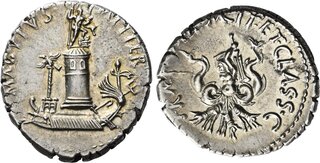| Numismatica Ars Classica > Auction 143 | Auction date: 7 May 2024 |
| Lot number: 419 Price realized: This lot is for sale in an upcoming auction - Bid on this lot  | Show similar lots on CoinArchives Find similar lots in upcoming auctions on |
| Lot description: The Dioscuri Collection. The Roman Republic. Sextus Pompeius. Denarius, Sicily 37-36, AR 20 mm, 3.97 g. MAG·PIVS – IMP ITER Galley with aquila on prow and sceptre tied with fillet on stern; in the background, pharus of Messana surmounted by statue of Neptune, holding trident and rudder, placing l. foot on prow. Rev. PRÆ[F·ORÆ·MARI]T·ET·CLAS·S·C· The sea monster Scylla wielding rudder with both hands. Babelon Pompeia 23. C 3. Sydenham 1349. Sear Imperators 335b. Woytek, Arma et Nummi p. 558. RBW 1786. Crawford 511/4d. Very rare and in exceptional condition for the issue, undoubtedly among the finest specimens known. Struck on an extremely large flan and exceptionally complete for the issue. Wonderful iridescent tone, virtually as struck and almost Fdc Ex Tkalec sale 29th February 2008, 295 (illustrated on the front cover) After the assassination of Julius Caesar on the Ides of March 44 BC, the Senate entered into negotiations with Sextus Pompey, a son of Pompey the Great, who still retained a significant army and fleet after Caesar's defeat of the Pompeian forces in Spain at the Battle of Munda in 45 BC. In April 43 BC the Senate had granted him the title of praefectus classis et orae maritimae (Prefect of the Fleet and Sea Shores), which is employed on the reverse of this denarius. By August, the political winds had drastically changed at Rome and at the instigation of Octavian and Sextus was named as a public enemy. He responded using his fleet to rescue fugitives from the bloody Caesarean proscriptions in Rome and took control of Sicily to serve as a base of operations for blockading Italy and launching raids on its coastline. In 42 BC, Octavian's general, Q. Salvidienus Rufus, attempted to invade Sicily and expel Sextus, but he was defeated. Sextus replied in 40 BC by using his naval forces to seize the island of Sardinia from Octavian's governor. By this time, he had shown himself to be so well-entrenched in Sicily and so dangerous to Rome through his continued blockade that in 39 BC, the triumvirate of Octavian, Mark Antony, and Marcus Lepidus, attempted to make peace with him by agreeing to the Pact of Misenum. This settlement recognised Sextus Pompey as the legitimate governor of Sicily and Sardinia as well as Corsica and the Peloponnesos while at the same time promising him a future augurate and consulship in 33 BC. In return, he was to end the blockade and supply Rome with grain. Sextus happily agreed to the terms of the pact, but it really only represented a temporary truce. In 38 BC, Octavian accused Sextus of violating the pact and attacked him again, only to be defeated in naval battles off Cumae and Messana. Unfortunately for Sextus, fortune turned against him in 36 BC, when a successful invasion of Sicily was mounted by Lepidus and Octavian's general, Marcus Agrippa inflicted a great defeat on his fleet at the Battle of Naulochos. Sextus fled to Asia with a remnant of his former navy , but he was forced to surrender and handed over for execution. This denarius is usually thought to have been struck at the height of Sextus Pompey's power, before the Pact of Misenum, due to the use of the titulature granted to him by the Senate in 43 BC. However, the types, which strongly refer to the Strait of Messina, may perhaps point to production in 38 BC to celebrate Sextus' victory there over Octavian. None of Sextus' coins actually give him another title superior to praefectus classis et orae maritimae. Whatever the case, the Messinian emphasis of this issue is unmistakable. The obverse depicts the pharos, or lighthouse of Messina, built to guide ships through the dangerous waters between Italy and Sicily, while the reverse depicts Scylla, the sea monster composed of a female body terminating in the tail of a sea monster and the heads of braying hounds that was believed to inhabit the Strait. She famously attempted to destroy the ships of the heroes Odysseus and Aeneas with the assistance of the monster Charybdis, who lived across the Strait from Scylla. The representation of Scylla on the denarius shows her violently attacking with an oar, which would be a most appropriate allegory for Sextus' defeat of Octavian's naval forces. Estimate: 15000 CHF |  |



